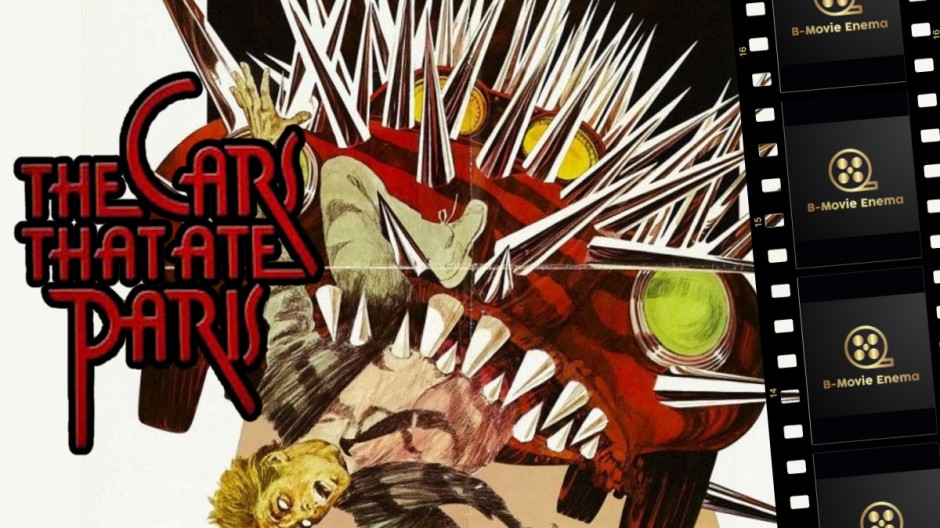Welcome to B-Movie Enema for another review to sate your appetites.
So I was trying to think what would make for a good review for this week. I was driving along the roads of New South Wales in Australia and took a detour into the French countryside. I eventually found my way through my European GPS, which was just some road signs, to a strange little village. That’s when it struck me… I want to talk about Peter Weir’s The Cars That Ate Paris.
Turns out, the same inspiration that struck me to talk about this movie with a very peculiar title was the same inspiration that struck Weir to make the film to begin with. He was in Europe and claimed that the road signs on the French roads diverted him into what he called strange little villages. From this, being an outsider from a wholly different continent, he got the idea to make a movie where the inhabitants of a small village, that he named Paris, profit from car wrecks.
After coming home to Australia, Weir got to work on the film. Originally, it was intended to be a comedy. Over time it evolved into only part comedy by way of becoming mostly a horror film. Weir secured most of the budget from the Australian Film Development Corporation. By October 1973, Weir went to work in Sofala, New South Wales.
The film was released in 1974, but struggled to find an audience. Weir tried to get the film distributed in the United States through a deal with Roger Corman, but that fell through. Interestingly, after seeing the film, Corman charged Paul Bartel to make Death Race 2000, but Bartel only knew of the existence of the print in Corman’s possession and never watched it. It’s hard to say if that piece of information I discovered about Weir and Corman trying to bring the film over here was intended as Corman’s idea for Death Race 2000 came from The Cars That Ate Paris. It might be connected, but both became cult hits. Eventually, New Line Cinema did get the film over here in 1976 with the title now showing The Cars That Ate People and had some small changes made to make it a little more palatable for American audiences. By 1980, the film was paying off for producers though. So it ultimately did okay over the course of years.
Interesting fact to add here… The Cars That Ate Paris is one of Stanley Kubrick’s favorite movies.
Weir rocketed to serious levels of reputation after this film. The following year, he made the hauntingly wonderful Picnic at Hanging Rock. But then, in 1981, Weir made Gallipoli starring Mel Gibson. In 1982, he directed the Oscar-winning The Year of Living Dangerously. In 1985, Weir got his first Oscar nomination for Best Director for Witness. He followed that with three more Best Director nominations for Dead Poets Society, The Truman Show, and Master and Commander: The Far Side of the World. He also got an Oscar nomination for Best Original Screenplay for 1990’s Green Card. Just last year, he was given an Honorary Oscar for his expansive body of work.
So, Peter Weir, while seemingly retired, he’s a big deal. In fact, he’s basically the leading figure of the Australian New Wave. It was through this movement that we got Ozploitation with movies like Thirst, Mad Max, Snapshot, Turkey Shoot, and more. Some pretty darn big names are part of this movement too. Not only did this era bring us Weir and George Miller as big-deal directors, but we also got Mel Gibson who would go on to be one of the biggest action stars of the 80s and 90s, Sam Neill, who taught me a hell of a lot about the mostly fictitious velociraptor, Crocodile Dundee himself, Paul Hogan, and Nicole Kidman. We all know Nicole Kidman is our goddess high priestess of going to movies thanks to her divine words about being enthralled at an AMC Theatre.
ALL PRAISE THE GODDESS HIGH PRIESTESS NICOLE KIDMAN!

Uh… Okay. Glad to get that out of my system. Let’s talk about some cars that eat Paris and/or people.
The movie opens with some pretty rad funk rock as a couple takes a country ride in a convertible Datsun. It’s wonderful and pleasant. They see a sheep farmer. They buy some art. They enjoy some Alpine smokes. They enjoy a Coke. It all looks like a commercial or some sort of advertisement for a way of life. But then, their front driver’s side tire suddenly wobbles and falls off. The car careens off the road and tumbles down a hill. The couple and their little dog die.
We next meet brothers Arthur and George Waldo. They live out of a camper they tow behind their car. They travel from town to town seeking employment. After George gets shooed away from one employment line, they continue onto the next village – Paris. With little light on the road into town, George is blinded suddenly by a light beaming into the car while Arthur sleeps. The car flies off the road destroying the camper and killing George.

An insurance investigator comes out and inquires about the accident. He’s told that the car was burned out and unsalvageable. Arthur wakes up in the hospital where he’s told George died. He says he heard lots of weird noises and saw a bunch of lights. However, a local tells him it couldn’t be car lights because it was a one way road. There was “no way” there was another car on the road with them.
Arthur undergoes psychiatric treatment at the hospital. He’s shown pictures of various things. Mixed in with that, the doctor shows him gruesome pictures of deadly accidents. It’s not entirely clear as to why the doctor is doing this to Arthur. I suspect it could be three things. It could be the doctor really is trying to help Arthur cope with being in an accident and thinks having him confront the horrors of something like that will help. The other two possibilities are much more sinister. It could be that the doctor is just a cruel person and is kind of psychologically torturing Arthur. It could also be that he’s hoping this will upset Arthur to the point of suicide to remove him from any further questioning or interference with this town’s ultimate motives.
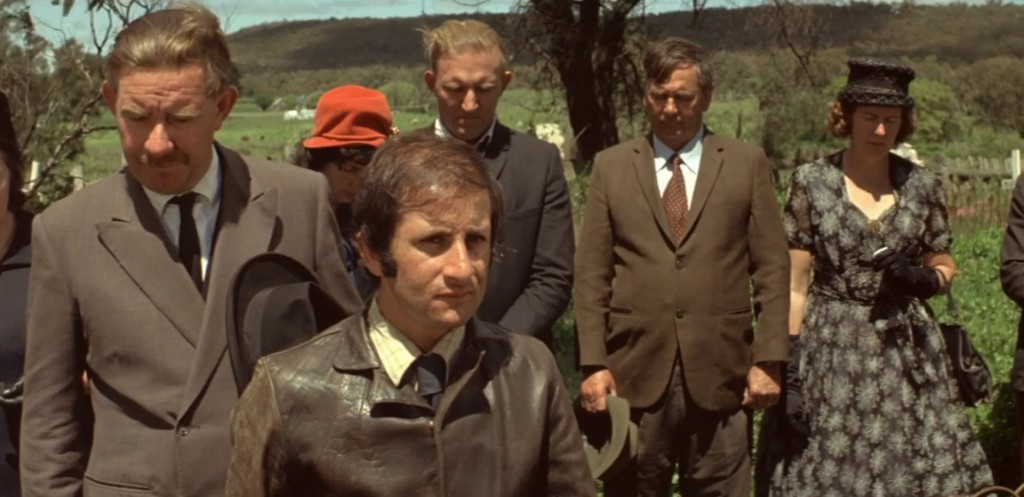
Arthur is released from the hospital where he meets Mayor Len Kelly. Mayor Kelly, along with the rest of the town of Paris, provides funeral and burial services for George. Later, Mayor Kelly is having a meeting with other officials. They bring up the question of what the plan is with Arthur Waldo. Mayor Kelly says he’s decided to keep him.
Arthur is kind of a strange person. He doesn’t seem all there if you know what I mean. He’s meek. He doesn’t seem very intelligent. He almost comes across as childlike. It makes a little more sense now that George was the one who was trying to get work while Arthur stayed in the car earlier on. He’s adopted by Mayor Kelly and kept like a child would be. Even his wife speaks to him kind of like a child. Thinking it would cheer up the new addition to the family, she shows Arthur her real mink coat. She also seems a little… off.

Also in the Kelly home are two girls. One of the girls has a nasty scar on the side of her face. When Mrs. Kelly sees the girl has exposed the scar, she signals to her to cover it up. These two girls are also orphans of car accidents in Paris. Later, Arthur is questioned by Mayor Kelly about seeing lights just before the accident. Arthur doesn’t say too much other than he feels guilty about George’s death. If he was driving, they’d both still be alive. However, Arthur can no longer drive.
About a year prior, he killed an elderly man walking in the road with his car. Arthur was brought up on manslaughter charges. He was eventually acquitted, but all of that still lingers with him. As Arthur goes to bed, he hears somebody carrying on. When we go back to the hospital, we find there is a ward of people with pretty serious mental issues that are kept there.

For a tiny town out in the Australian country, Paris seems to have a lot of sinister mysteries.
Also that night, another accident occurs outside of town. It’s a similar situation to Arthur and George’s crash. The car was driving along the dark road and suddenly the driver was blinded by bright headlights. The car is brought into town and stripped of useful parts and personal items. Once the car is stripped, it’s lit on fire to destroy the rest of it. The driver, who survived the accident, is drug into the hospital where the psychologist lobotomizes him with crude power tools. He’s then put into the ward with the other “veggies” that are used for terrible experimental purposes.

Arthur, unaware of what is really going on here in Paris, plans to leave. He doesn’t have a car to leave with, and he wouldn’t be able to drive it anyway since that whole ordeal with the elderly pedestrian. He tries walking out of town but is forced back by two ghastly-looking cars blocking the road and honking for him to return. He decides to then wait at a bus stop. Eventually, he’s summoned to the Mayor’s Office.
Mayor Kelly tells Arthur that the doctor came with a bunch of technical rubbish that he can’t leave because he’s a sick man. The doctor’s diagnosis is that Arthur is dealing with the death of two men on his conscience and a pretty bad fear of driving. If he doesn’t stay and confront these issues, he’s only going to get worse. Mayor Kelly says Arthur can do one of two things. He can either accept the free help from the doctor or he can go outside, get into the car waiting for him, and drive off.
Arthur ponders this for a bit. He eventually decides to get in the car and try to leave. However, once he starts the car, he can’t bring himself to put it in gear to drive off. Feeling trapped in the car and starting to panic, he gets out and accepts the help of Mayor Kelly and Dr. Midland. As life goes on, he eventually takes a job as an orderly at the hospital.
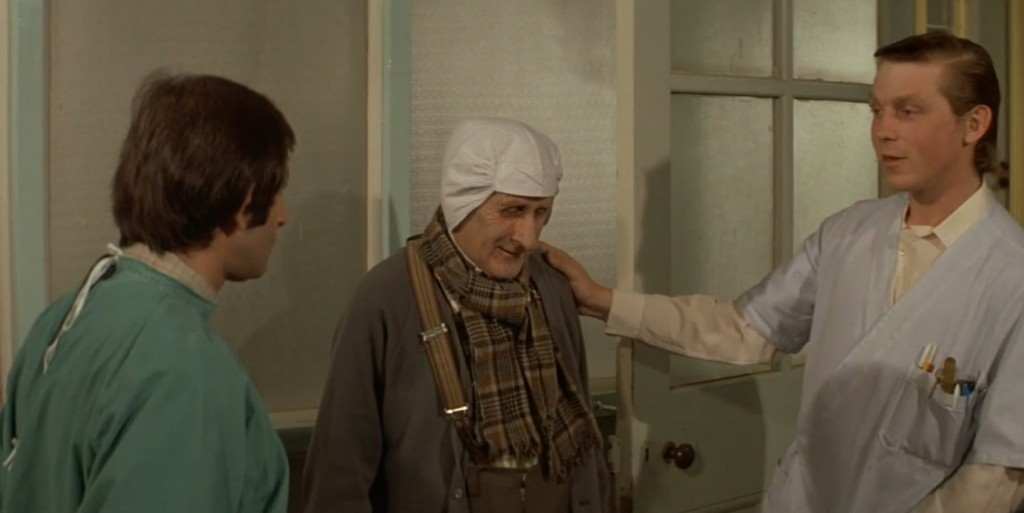
Arthur learns about the “veggies” and the different kinds that are in the ward. Some of them are totally vegetative. Some are pretty seriously messed up. Some of them are basically the older folks in cognitive decline. The nurse whom Arthur reports to tells him about George.
This leads to Arthur no longer wanting to work at the hospital. He confides to Mrs. Kelly about how George had to look after him. George had to help raise him. He wasn’t all that sure that George even liked him that much. He always went on about how weak he thought Arthur was. That’s when Mrs. Kelly says that her husband also thinks she’s weak on account of her not being able to have children. Arthur then learns that the two girls at dinner the other night are orphans from previous accidents. This seems to maybe tickle something in Arthur’s brain.

After Mayor Kelly tells Arthur that he can’t really stay with the family after tonight, Arthur revisits his statement about how he really did see lights the night of the accident and excuses himself for bed.
So throughout the movie, a couple things have been laced throughout the goings on in and around Paris. I mentioned that the Mayor has his daily meetings with other officials. In one of those meetings, he mentioned that the young people of Paris need to get to work. Paris is boiling over with a war between the generations. Yes, the town is involved with some shady business that deals with wrecking out-of-towners who drive into and around Paris. In fact, even the newer pastor of the town church, Reverend Mulray, seems to think that maybe they should fix their bumpy roads in Paris. The youngsters, though, take several of the wrecked cars and modify them. They make these bizarre creations and more or less terrorize Paris with them. They seemingly only want to drive the cars into things and each other. The people of this younger generation, and their activity with these modified cars, are what’s referred to as hoons.

Arthur again considers leaving Paris. Before getting out of town, Mayor Kelly tracks him down and asks him to stay with the Kelly family. He wants to basically adopt the young man as his son. While, yes, Arthur will get a home to live in with the Kellys, the trade-off from Mayor Kelly is that Arthur is to not speak to outsiders. They are to keep to themselves. It’s pretty obvious that Mayor Kelly is concerned that Arthur is unwavering in his story about seeing lights before the accident.
The following day, Mayor Kelly appoints Arthur as the town’s new Parking Superintendent. He’s provided an armband with his rank and is given something of a military-style jacket. He’s to help keep the town clean which allows for the town to grow and modernize. I’m not exactly sure what the hell any of that means. I mean, is he just going to go around and give out tickets like a meter maid? Or is he going to be zoning things or just wearing an armband that says he’s the Parking Officer?
I mean… Okay, yeah, it’s to buy Arthur’s silence and obedience, but you know what else it does? It pisses the hoons off. After appointing him, a couple of the hoons drive their cars into the Kellys’ fence and break an Aboriginal statue of his. They drive off yelling things at Kelly.
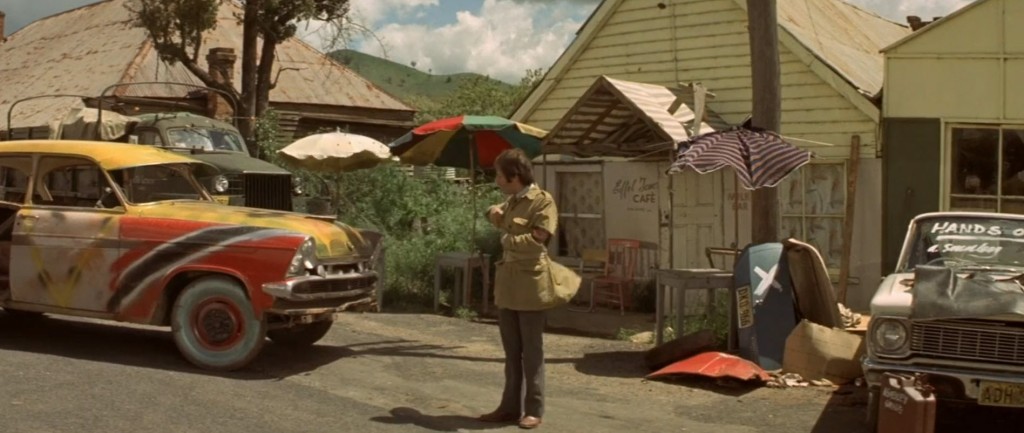
On the first day of his new gig, Arthur goes around and looks at some of the hoons’ cars parked haphazardly on the side of the roads. He marks their tires and writes something in his little book. He discovers Darryl, his old boss from the hospital, owns one of the cars he plans to report.
This leads to a good old-fashioned showdown in the streets of Paris between Arthur and the hoons led by Darryl. Arthur tells Darryl that he needs to move their cars. The hoons think Arthur is an outsider and he shouldn’t be telling them what to do. In fact, they think he should have died along with George or become a veggie. The sheriff brings a couple of them in to question them about messing up the Mayor’s property.
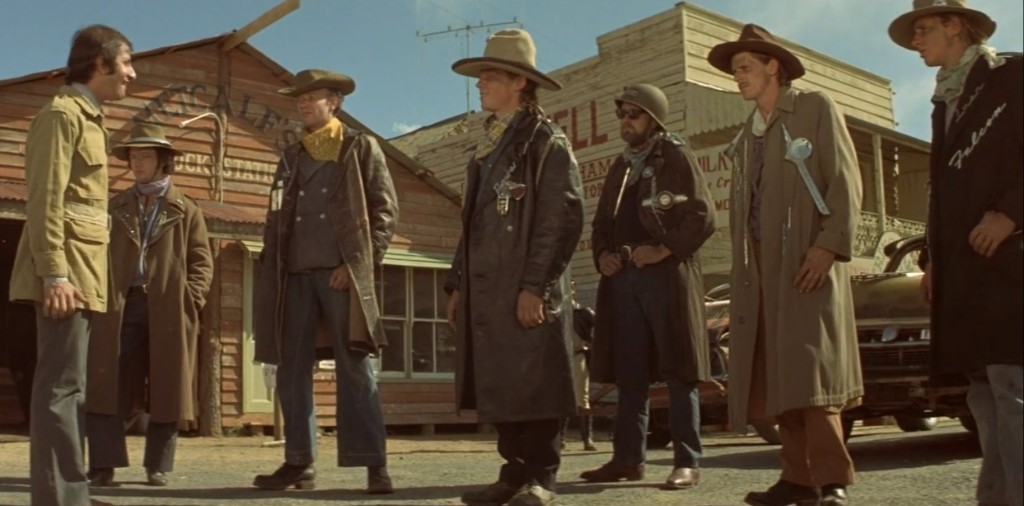
The Mayor brings everyone outside to make an example of the hoons. He has one of his workers burn one of the hoons’ cars while others hold him down. He says this is a message to anyone who defies the laws of Paris.
Soon after, the shit hits the fan. Charlie, someone who works at the junkyard, decided to go shooting. He’s not shooting fowl or dingos or whatever. He’s shooting at the car of Reverend Mulray who is an outsider, but someone who has a lot of connection to Paris. This pisses Mayor Kelly off something terrible. This is going to be much harder to hide and cover up. This was an accident in broad daylight when most of the time it’s the ones at night that should be happening. Charlie defiantly says he’s done nothing wrong. After all, everyone else always takes what they want and he just sits to the side. This time, this was his. He convinces everyone to agree this was a shooting accident.
One problem, though… Arthur has witnessed everything and he’s not too sure about the plan to hide all this evidence. Not only that but Arthur attempted to speak to the reverend after church on the previous Sunday. That led to Mayor Kelly “adopting” Arthur and giving him his new position as the Parking Guard.

Tonight is the night of the big Paris Ball that celebrates the town and raises funds, etc. It was decided to make the ball a formal wear thing, but I’m guessing in the rural areas of Australia “formal wear” just means “costumes” because the sheriff shows up in what looks like a kid’s cowboy costume. Arthur is wearing a silly yacht captain costume. Someone else is dressed in a rice paddy hat and a sign hanging in front of him that reads “Chinaman”. Australia is weird, man!
The mood of the place is already pretty somber. In addition to that, Arthur didn’t want to go. He’s got a lot to ponder after seeing what went down earlier in the day. In fact, it even looks like he’s trying to leave town yet again. So add that to all the weird costumes. However, the most bizarre thing to happen? Quite frankly, not only did I not expect this to happen, but I would have never had any expectation that this could have ever happened at the town ball.
The veggies show up with Dr. Midland and they do not disappoint.

As the town ball continues on, the hoons start gathering on the outskirts that look over the town. After the death of Mulray, Mayor Kelly ordered the roads closed. If anyone tries getting in or out, there are traps that are set up to deal with the problem. The road worker tells the Mayor that the hoons are pretty damn upset over one of their cars being burned up like it was earlier in the day.
Now, I want you to realize that there’s one image that is most directly tied to this movie. Regardless if you live somewhere that had this movie in video stores under the title The Cars That Ate Paris or The Cars That Ate People, you have likely seen what I’m going to refer to as the hero car of the movie. The hoons pull into town behind a heavily modified VW Bug that is completely decked out with sharp metal spikes.
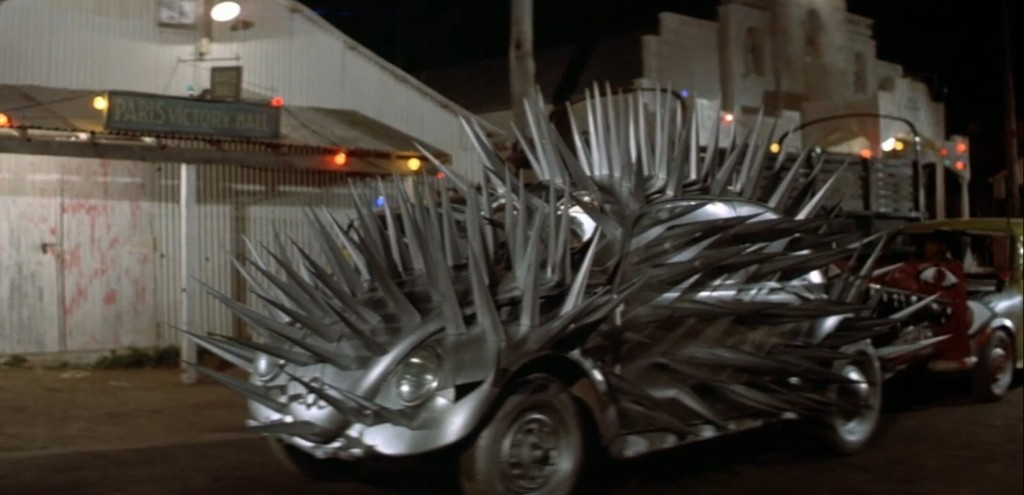
Now THAT is a striking image to sell the movie on.
The hoons begin destroying the town. They run their cars into the buildings. They attack the gas station and the Mayor’s house. They tear down the front of City Hall. They start lighting cars on fire on the streets. They have also killed the road worker and chained him to the hood of one of their cars. The older generation of the town fights back by stabbing into the windows. However, one of the town’s officials tries doing a little too much on his own and he gets run into and impaled by the spiked Bug.

Arthur tries hiding in the Mayor’s car but when one of the hoons finds him and tries bashing into the car, Arthur starts Kelly’s car and, at the direction of the Mayor, he uses the car to ram backward into Darryl’s car. Mayor Kelly pats Arthur on the back for killing Darryl. Arthur, initially horrified by what he did, soon comes to the happy realization that he can once again drive.
The town is destroyed and the people who are still alive, plan to leave. They’ve packed all their valuables and walk out of the town. The Mayor pleads with them to not drive because there are traps on the roads in and out, plus it’s blocked off. Arthur finds a car like George’s and leaves along with the rest of the surviving townsfolk. The only person remaining in Paris is Mayor Kelly.
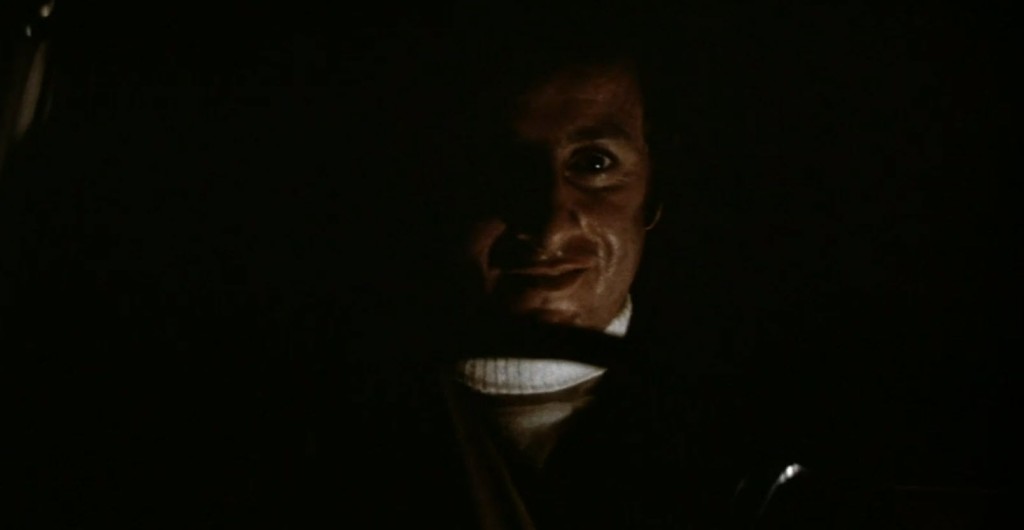
The Cars That Ate Paris is a good movie. It’s interesting in a lot of ways too. The characters are almost devoid of any real depth but I think that’s on purpose. Arthur is the closest thing to anyone who comes close to having an arc, but really all he regains is his confidence in driving. He is a terribly flawed human being mostly due to always being meek and weak. Well, at least weak in terms of what his older brother thought of him.
You think about movies and try to find extra meaning in them. I don’t think The Cars That Ate Paris wants you to think too much about it. It’s obvious that you really can’t think too long about it because you’ll start to nitpick about the town’s motives and never really ever being caught in their schemes. The people of Paris are simply no good and xenophobic. They are fairly simple in their very small town ways. They don’t seem to care much for outsiders, so they go to wrecking them and taking their stuff. If people survive, let the ol’ kooky doctor have them for his crazy experiments. The Mayor is clearly in on this and he uses it to his advantage to fund the town, keep people clothed, and then also to have children when his wife is physically unable to.
How would these schemes really work? When did they come to the decision to do this to passer-bys? Has anyone ever thought about what they are doing and feel guilty? If so, are they sent off to be one of the veggies? Maybe… there’s that one old man who used to be the bank president who’s now a veggie.
The thing is, though, it turns out all that is secondary to a much larger problem festering inside Paris.
Really this movie is probably more about dying towns and the natural friction between generations. This was something that has been a problem all across the world in countries that modernized post World War II. As technology and social conditions changed and shifted and evolved, smaller towns holding onto their traditions and their pasts, and then expecting to pass that along to the next generation, suffered. There’s always going to be a desire to remember where you came from and what once stood there, but forcing it onto a younger generation when they want to be part of a larger world has almost always gone poorly.
Then, to add to that, Australia has this punk rock attitude about it, doesn’t it? Think about movies like Mad Max, Turkey Shoot, or Dead End Drive-In. Each of those movies has two common things featured in them – a dystopian element and someone, or some people, standing up against it. This movie has a similar feel to those as well. The small town is very dystopian in the idea that they seem good and pleasant on the surface, but they kill outsiders like it’s a totally normal thing to do. Then you have the younger generation, the hoons, who build their crazy cars and just try to disrupt everything. Granted, the hoons are positioned as a danger in this movie, but I’m not too sure, until they really point their attention toward Arthur, that we aren’t so sure about them. If we think about this kind of logically, the hoons are a byproduct of a broken system within the town.
I kind of feel like I’m rambling. The point is that this is an interesting movie that doesn’t necessarily play by the normal rules of other movies. It’s a good example of Ozploitation and probably a good example of the risks Australian filmmakers would take. It’s shot well and the performances are all fantastic. Plus… The hoons’ cars are something that I could see a whole collectors’ line being produced. The spiky VW Bug is just fantastic.
One last thing I want to bring up before I leave the small town of Paris… There are two somewhat recognizable faces in this film. The first is the guy playing Charlie, the junkyard worker and possible light veggie who kills the town’s reverend. He is played by Bruce Spence. He’s best known for playing the gyro pilot in The Road Warrior (known outside of the U.S. as Mad Max 2). He’s a guy who is immediately recognizable once you lay eyes on him. The guy who is much less recognizable is our lead, Terry Camilleri. Camilleri was best known for appearing in several Australian and American productions. Mostly, he had smaller roles, but he had a very pop culturally significant role in Bill and Ted’s Excellent Adventure as Napoleon. How about that? Anyway, I just wanted to make sure that I covered that for those who were already in the know so they wouldn’t plow their spiky WV Bug into my apartment for not mentioning these two actors.
So, this week is done. We’re going to leave Australia and come back to the United States. There, we’re going to travel to Texas where we’ll pull into our spot in the front row to review a coming-of-age comedy from 1976 called Drive-In. Be back here in a week and check out what I have to say about this little-known gem.

